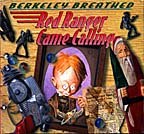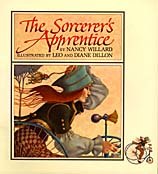Wendy Jackson interviews Fonda Snyder, co-founder of Storyopolis, a unique company which is a symbiosis of a bookstore, art gallery, development think tank and production company.

In recent years, books have been the fodder for a herd of animated series and films. The past five years alone have brought us animated adaptations of literary works, other than comics, from authors such as Roald Dahl (James and the Giant Peach), Victor Hugo (The Hunchback of Notre Dame), Kenneth Grahame (The Wind in the Willows), Astrid Lindgren (Pippi Longstocking), Jean & Laurent deBrunhoff (Babar), Else Holmelund Minarik (Little Bear) and most recently, Marc Brown (Arthur), Paulette Bourgeois (Franklin), A.A. Milne (Winnie the Pooh) and William Joyce (Rolie Polie Olie). These days it is widely recommended that startups first pursue publishing a book or comic to establish an original property before trying to pitch it as an animated concept.
As the trend towards creator-driven content is catching on in the animation industry, an intrepid, relatively new player is entering the field, literally armed with shelves of original book properties. Storyopolis, a multi-faceted company that started as a concept to showcase art by children's book illustrators, was founded in December 1994 with the financial backing of Microsoft co-founder Paul Allen, and the creative vision of founding principals Dawn Heinrichs and Fonda Snyder. A symbiosis of a bookstore, art gallery, artists' management company, development think tank and production company, Storyopolis bridges both publishing and visual media.
Storyopolis' production arm currently has a first-look deal with Warner Bros. where they are producing three features including a live-action adaptation of Steve Seagle's best-selling comic book House of Secrets, and two animated movies. The Iguana Brothers, is an animated feature based on the book by Tony Johnston and Marc Teague, and is described as a road movie featuring two iguanas who travel to Rio for Carnivale. The Sorcerer's Apprentice is based on Nancy Willard's female version of the classic story. For this film Storyopolis is partnered with Geena Davis, who is attached to voice the main character. Other Storyopolis projects in development include a live-action/computer animation feature Red Ranger Came Calling, a "'90s style Christmas story" based on a children's book by cartoonist Pulitzer Prize-winning Berkeley Breathed (Bloom County) and Sign of the Seahorse, an underwater action adventure based on the book by Graeme Base. Gracie Graves and the Kids From Room 402 isan animated television series based on the book by Mickey & Betty Paraskevas, which is being developed for Fox Kids Worldwide, and is described as "Seinfeld for third-graders."

I spoke to Fonda Snyder who heads up Storyopolis Productions to shed some light on the process of developing children's books into film and television properties.
Wendy Jackson: What is the mission of Storyopolis' production arm?
Fonda Snyder: The promotion of literacy is very important to Storyopolis. Most of our projects are based on books because not only is it our primary business to sell both illustrated storybooks and the original art from those books, but it is also proven that in this electronic age, children and adults are more likely to read a book that they have seen adapted to film or television. Fortunately or unfortunately, a visual adaptation is more likely to reach the largest audiences. Even an author with the highest renown like Maurice Sendak has been said to comment that in a lifetime of touring and reading to audiences, he would still not be able to reach the number of children that a television series does.
Children are so visually sophisticated these days and yet they will always be affected by heartfelt human interaction. We strive to transcend generations by creating truly clever, interesting, unique and intelligent material with a strong sense of humor, avoiding cliché and saccharine emotion. Ultimately, we are hoping to encourage kids to go back to the book and read for themselves after viewing the material we produce.
WJ: There are thousands of books out there. Why do some lend themselves to series or feature development? What do you look for?
FS: Story! Storyopolis was created as a city of stories, and as such acquires franchise-oriented properties with strong stories, dynamic visuals, a great sense of humor and a "slightly tilted" sensibility that will entertain a sophisticated and fun-seeking audience of all ages. We are especially attracted to the classics, myths, fairytales and fables. The Art Gallery and Bookstore, which provides a unique dialogue with the company's target audience, serves as our own built-in testing and research center.
WJ: How do you go about optioning and developing books?
FS: My partner Dawn Heinrichs, who runs the gallery/bookstore and the overall business side of Storyopolis, constantly combs the world to find the best in illustrated works. Because of our unique setup and the research and development center at Storyopolis, we tend to have our pick of material far in advance of other producers and buyers. We often find that we discuss ideas with our authors and artists sometimes in advance of them writing the material and have a hand in encouraging them to work on a property that we will ultimately produce.
Thus, our business is reliant upon our close relationship with our authors and artists. We have very strong and special relationships with the authors and artists whose work we exhibit. Often we utilize these relationships when deciding what material to option.
We also work the traditional route. Our development person and I seek out the estates and/or publisher and/or agent to find who owns a property that has either recently been reviewed or that we have been intrigued in from our own travels through the myriad of book publishing trades and from history. There are many books and characters that I remember from my own childhood that we have sought out to develop.

WJ: Can you take us through the steps of a project?
FS: One example of an ideal property for us is Berkeley Breathed's book, Red Ranger Came Calling. We were extremely lucky to outbid our competitors for the rights to the book and to work with an extraordinary artist who thoroughly understands and has studied and mastered the craft of screenwriting. The book was actually written in three acts with the film adaptation in mind. As a cartoonist and writer, Berkeley fully understood and embraced the demands of both mediums and was able to switch between the two, allowing for the very disparate needs of each. As a screenwriter, he was essentially storyboarding the script before and during writing. He wrote very much like a director because of the strength of his experience with the comic strips (Bloom County) and his love of film.
WJ: What about stories? Do you develop new storylines and characters to expand a property for more content?
FS: It depends on the specific property. Some projects come with a fully developed storyline while others come with a wonderful idea or premise that needs to be fleshed out before it can become a successful TV or feature film project. It is very rare that a children's book will be written in three acts. It is rarer still to find a children's book that is appropriate in its entirety to adapt for film. Often there will be a great concept, a world established with fun characters or a public domain title with a contemporary twist that is always a hot commodity if cleverly adapted. It is almost guaranteed that there will have to be a great deal of flexibility with the creator to accommodate its adaptation into another medium. It is inherent that a children's book especially will have to be expanded and characters further developed when taking it to another form.
WJ: What are some of the qualities of a book property that lends itself to animation, as opposed to live-action?
FS: I believe the line between the two is actually becoming more and more blurred. Animation is moving into many fascinating new territories as of late, with The Prince of Egypt, Anastasia, The Iron Giant, Antz and effects-driven live-action movies like Babe, Men in Black and others. Many stories that would never have been thought of for animation are now being successfully executed and many films that might only have been considered for animation are being done in live-action. WJ: What is your working relationship like with book illustrators and authors? Do you just buy the rights and take it from there, or are the creators involved in development and production? FS: The very nature of Storyopolis provides for an especially artist-friendly environment. We work together with each author and/or illustrator to bring their project to life on the screen. It is important that the artist's vision be kept alive in all stages of development so that the end result is truly representative of their vision. We work extremely closely with the authors and illustrators to maintain their intent and to keep a close watch on quality control.
 The Storyopolis Art Gallery and Bookstore provides a unique dialogue with the company's target audience and serves as a built-in testing and research center. Recent exhibitions include art by Tim Burton, Quentin Blake, William Joyce and Maira Kalman. © Storyopolis.
The Storyopolis Art Gallery and Bookstore provides a unique dialogue with the company's target audience and serves as a built-in testing and research center. Recent exhibitions include art by Tim Burton, Quentin Blake, William Joyce and Maira Kalman. © Storyopolis.
Sometimes an artist or author does not want to be involved in the writing of a film or television series and then we will create the best team of talent that shares the similar intent and sensibility so that we can closely equate the underlying property as it serves us and the creators.
WJ: How do you work with a large studio like Warner Bros.? What is Storyopolis' role in the various stages of production?
FS: It is both challenging and exciting to have a relationship with a powerhouse studio such as Warner Bros. The resources and support they provide have proved invaluable. As a producer with a first look deal, we are responsible for bringing quality material to Warner Bros. that we believe in.
We are also careful not to take a property in that might not be developed appropriately enough. I have worked in the studio system for years and I am very aware of the parameters of the studio system and what needs to be created for presentation to executives. We will often option the material first and develop it to the point we believe it will be salable to the studio and then pitch it when we know that there is enough. We have also commissioned the writer to write a screenplay before submitting it to buyers. To ensure that the project is moving forward at Warner Bros., we work with one executive on the live-action side and one on the animation side.
As a producer, our role is to run interference to smoothly manage a project from inception and option, negotiations, through development and production. We are involved in every step of developing and managing a project until it appears on screen.
Storyopolis' bookstore is located at 116 North Robertson Blvd. in Los Angeles (between Third St. and Beverly Blvd.). For information call (310) 358 2500.
Wendy Jackson is Associate Editor of Animation World Magazine.







